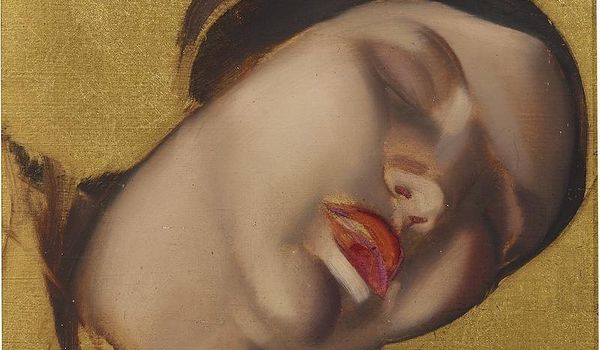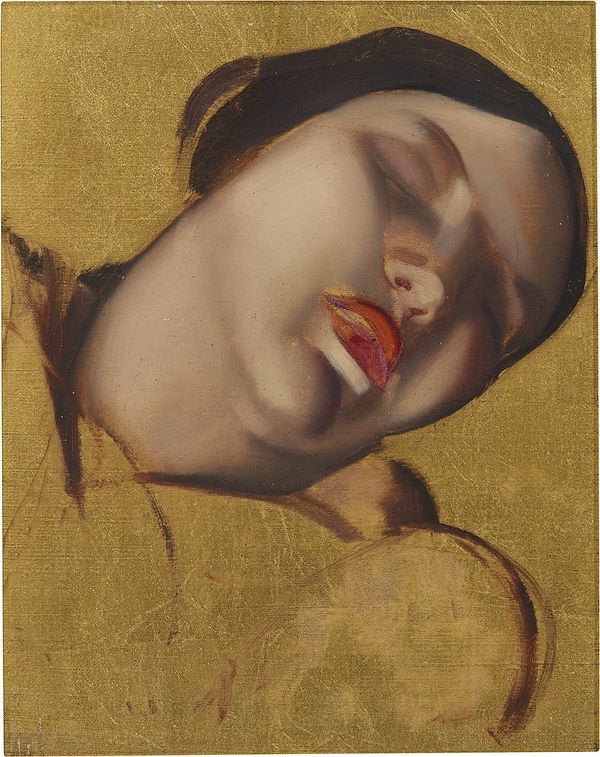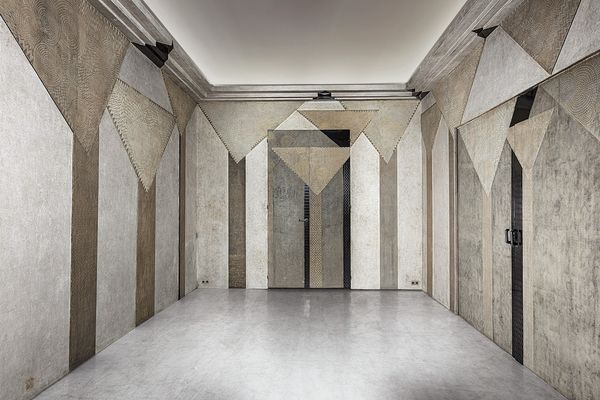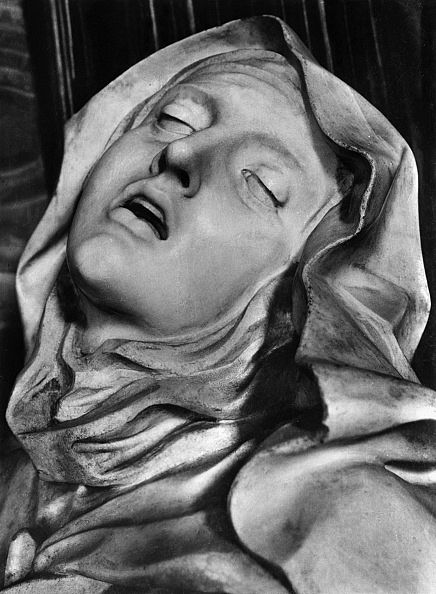Tamara de Lempicka, Figure esquissée sur fond doré (detail), circa 1930. Estimate On Request. 20th Century & Contemporary Art Evening Sale London.
On the occasion of offering Figure esquissée sur fond doré by Tamara de Lempicka in the April 15 London Evening Sale of 20th Century and Contemporary Art and Jean Dunand’s art deco masterpiece Les Palmiers, commissioned by Colette Aboucaya, in the June 30 Design sale in London, design Specialist Kimberly Sørensen and Senior International Specialist and Regional Director, Zürich Lori Spector discuss the lives of these two remarkable women.
Kimberly Sørensen: Lori, what is the relationship between the world that Tamara de Lempicka depicted in her work and her own life?
Lori Spector: Kim, this is such an important question, as I think it is so integral to Lempicka’s practice. Tamara was absolutely, 100% a creature of her time and of her own self-invention. She arrived in Paris in 1918, a refugee of the Russian Revolution – she and her husband (and their small daughter Kizette) fled St. Petersburg where they had lived a fairly privileged and decadent lifestyle and basically needed to start from scratch in Europe. She needed to sell all of her possessions in order to make ends meet. Her husband, a lawyer by training, was in such a state of depression that he could not work. And Tamara made the decision that she was not going to sit idly by and wait for life to happen to her – she was going to make things happen for herself. Up until that point, Lempicka had been a self-taught artist, but upon her arrival in Paris, she took courses with leading artists of the time: Maurice Denis at the Académie de la Grande Chaumière, and a bit later with André Lhote at the Académie Ranson. She was determined to make a living as an artist. Lhote seemed to have the most influence on how her paintings developed, as she integrated Cubist characteristics and forms into her compositions. She clearly absorbed the lessons of the Mannerist painters of the Italian Renaissance as well, such as Pontormo and Bronzino, whose works she first encountered as a 13-year-old girl on a tour through Italy with her grandmother and must have revisited on numerous trips to the Louvre, where she spent a tremendous amount of time upon her arrival in Paris. There, she also discovered the work of Ingres whose depictions of the female nude surely made an impression.
Tamara de Lempicka, Figure esquissée sur fond doré, circa 1930. Estimate On Request. 20th Century & Contemporary Art Evening Sale London.
By 1922, it is clear that Tamara had become fully integrated into Parisian society and the avant-garde. She capitalized on her social connections and moved between painting portraits of the European elite and voluminous nudes of her friends and lovers. Lempicka once said that, “My goal was never to copy, but to create a new style.” She also famously said: “There are no miracles. There is only what you make.” And she went about cultivating an image of herself as a woman who rebelled against the roles of traditional female domesticity and fashion. She represented the apotheosis of a modern, ostensibly liberated woman – la garçonne – another emblem of the era. She captured women in a way that had not been done before – her paintings showed female rather than male desires and depicted female desires as both normal and acceptable, upending the canonical understanding of Western art history in the process. Her paintings from this period placed women in charge of their own pleasure and gave them empowerment to satisfy their own desires. So her practice and her life were so inextricably linked in that sense.
KS: That’s fascinating. So she was truly a self-made woman. It occurs to me that there’s a parallel here with Andy Warhol (also, coincidentally of Eastern European background!) who came to New York as an outsider, but who found commercial success through his portraiture of elite, avant-garde patrons. My understanding is that Colette Aboucaya, on the other hand, came from a more comfortable background. Her father, Léon Aboucaya, had in 1928 acquired the coachbuilding firm Henry Binder, which made ultra-luxury vehicles. In fact, this is how Aboucaya first came in contact with Jean Dunand, because he had designed and exhibited lacquered panels for Henry Binder automobile interiors at the landmark 1925 Exposition Internationale des Arts Décoratifs et Industriels Modernes. In the same exhibition Dunand included his famous smoking room for the French Embassy Pavilion, which is what served as the inspiration for the commission of Les Palmiers. Colette Aboucaya was widowed at a very young age, but whereas Tamara de Lempicka was notably extroverted with her feminine independence, by all accounts Colette Aboucaya was extremely introverted.
Jean Dunand, Les Palmiers smoking room, from the residence of Mademoiselle Colette Aboucaya, Paris, 1930-1936. Design London.
This is the reason that Les Palmiers has been so exquisitely preserved. She rarely accepted visitors and hardly even lived in or used the opulent interior that Dunand created for her. When she passed away at the age of 101, her nephew and heir had never visited the residence, which remained like a time capsule of a bygone era. When he entered he found that the rooms designed by Dunand and the decorator, Gérard Mille, had been practically untouched and that his aunt lived at the other end of the apartment, in what appeared to be a converted maid’s quarters near the kitchen. On the other hand, Tamara de Lempicka’s residence was like a stage. In 1929, right around the time the work on Les Palmiers began, Robert Mallet-Stevens designed a nine story apartment building on rue Méchain in the Left Bank, in which de Lempicka was one of the fourteen residents. Her atelier was well documented in a Mobilier et Décoration article from January 1931. The article’s author, G. Rémon, described the space as a “climat d’idées,” and interior views show that Madame de Lempicka lived in an environment unified by Mallet-Stevens’s vision, yet filled with the voices of other cutting-edge modernist talents such as René Herbst, Djo-Bourgeois, and her sister Adrienne Gorska. The gleaming metal surfaces of this interior are a stark contrast to the opulent lacquerwork of Les Palmiers and show the modernist direction the decorative arts were beginning to take at that time, particularly under the influence of the Union des Artistes Modernes (to which Gorska belonged). Lori, what do you think this interior tells us about Tamara de Lempicka?
LS: That’s how fully engrossed in the Art Deco moment she was, that she chose to live and work in this completely modernist space. She had a flood of commissions from all over the world from the 1920s until the early 1930s, the Great Depression pushed her somewhat into obscurity. But the gleaming surfaces of her portraits from this period are tributes to and symbols for the decadence and glamour of the era. Lempicka consciously built an image of herself as the extravagant protagonist of the European high life. She cultivated her artistic talent and in the process constructed her biography.
Interior of Tamara de Lempicka’s residence designed by Robert Mallet-Stevens, 7 rue Méchain Paris. © 2021 Estate of Robert Mallet-Stevens/Artists Rights Society (ARS), New York/ADAGP, Paris.
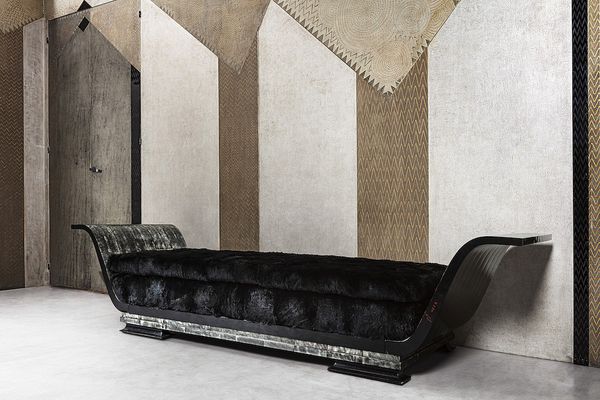
Katsu Hamanaka, Daybed, from the residence of Mademoiselle Colette Aboucaya, Paris circa 1935. Design London.
KS: How does Figure esquissée sur fond doré figure into her career?
LS: The work that we have coming up next week in London in our Evening Sale of 20th Century and Contemporary Art, Figure esquissée sur fond doré, circa 1930, is such a beautiful and iconic example from this prime moment in her career. Here this woman’s head is modeled with such tenderness, devotion, and economy of means against this glimmering gold ground, we believe it to be the only painting Lempicka ever made using gold leaf. There is an almost religious aspect to the work – I immediately think of Bernini’s magnificent 17th century sculpture Santa Teresa in estasi in the Cornaro Chapel of Rome’s Santa Maria della Vittoria, which Lempicka must have visited during her Italian voyage as a teen. The positioning of the sitter’s head, whose identity is unknown to us, is so remarkably similar to that of Teresa in the sculpture. Lempicka frequently depicted her female lovers, so perhaps one of them is the model here. But religion was another constant theme in her oeuvre, so it might also be an imagined Santa Teresa.
Gian Lorenzo Bernini, L'Estasi di Santa Teresa (detail), 1647–1652, white marble, Santa Maria della Vittoria, Rome. Image: Getty Images.
KS: Again, this reminds me of Andy Warhol, who must have been inspired on some level by the icons he encountered through his upbringing in the Byzantine Catholic church. But with Lempicka, you have a woman depicting another woman. This was an era when women were not only empowered, they were leading the way. In the world of design, you have Eileen Gray and Charlotte Perriand; in fashion, Coco Chanel, Elsa Schiaparelli, and Jeanne Lanvin, among others. These women were creative powerhouses but also major patrons of the arts. This is the world that both Colette Aboucaya and Tamara de Lempicka inhabited, though they navigated it in very different ways.
LS: Lempicka revolutionized the role of subject as a liberated and independent woman, thereby challenging the limitations imposed on the art and life of a woman. Here, woman is challenger of the male gaze not passive object. The current work could almost be categorized as an example of egalitarian voyeurism. The linchpin of her art is this bold, uninhibited female sexuality, which even in the context of contemplating religion or religious subject matter cannot be overlooked.
Discover More from 20th Century & Contemporary Art >
Recommended Reading
Moving a National Treasure >
Théâtres de Mémoire: Jean Dubuffet’s Last Decades >
